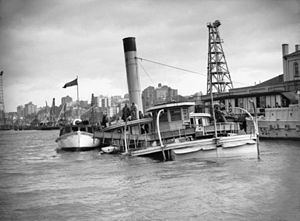Name Kuttabul Port of registry Sydney Launched 1922 | Yard number 54 Length 56 m | |
 | ||
Namesake Aboriginal word meaning wonderful | ||
HMAS Kuttabul was a Royal Australian Navy depot ship, converted from a Sydney Ferries Limited ferry. During the Japanese midget submarine attack on Sydney Harbour on 31 May 1942, Kuttabul was torpedoed and sunk, with 21 naval personnel aboard.
Contents
Design and construction
Kuttabul originated as a steam-powered ferry, built in 1922 by the Walsh Island Dockyard and Engineering Works in Newcastle for Sydney Ferries Limited. Kuttabul was rated at 448 gross and 201 net tonnes (1269 and 569 m³), was 183 feet (56 m) long, with a beam of 36 feet (11 m), and capable of seating approximately 2,250 passengers. Kuttabul and identical sister ship Koompartoo were the largest ferries ever operated on the inner harbour ferry routes, however Kuttabul had a larger passenger capacity (2,250) than Koompartoo (2,089). Both ferries were of steel construction with a wooden superstructure. Both vessels were constructed with 18 watertight compartments, regarded as being unsinkable and therefore were not required to carry life saving equipment.
Sydney Ferries
Kuttabul spent most of its life as a double-ended Sydney suburban ferry, carrying passengers across Sydney Harbour, linking the downtown ferry terminal at Circular Quay with various suburban ferry wharves, but especially the heavy route to Milsons Point.
Made redundant by the opening of the Sydney Harbour Bridge in 1932, Kuttabul and Koompartoo were laid up, but were later made available for tourist cruises on the harbour.
Royal Australian Navy
After the outbreak of World War II, Kuttabul was requisitioned by the Royal Australian Navy on 7 November 1940, and moored at the Garden Island naval base to provide accommodation for Allied naval personnel while they awaited transfer to their ships.
On the night of 31 May-1 June 1942, three Ko-hyoteki class midget submarines of the Imperial Japanese Navy entered Sydney Harbour with the intention of attacking Allied warships. Only one of the submarines, designated M-24, was able to fire her torpedoes, but both missed their intended target: the heavy cruiser USS Chicago. The torpedoes, fired around 00:30, continued on to Garden Island: one ran aground harmlessly, but the other hit the breakwater against which Kuttabul and the Dutch submarine K-IX were moored. The explosion broke Kuttabul in two and sank her,
The attack killed 19 Royal Australian Navy and two Royal Navy sailors asleep aboard the ferry, and wounded another 10. It took several days for the bodies of the dead sailors to be recovered, with a burial ceremony held on 3 June. One of the ferry's wheelhouses was salvaged and used as a naval police guardhouse at the Garden Island naval base; the base was commissioned on 1 January 1943 as the stone frigate HMAS Kuttabul in commemoration of the ferry and the lives lost. The wheelhouse later came into the possession of the Australian War Memorial, and is on display alongside a composite submarine built from the wreckage of two of the Japanese midget submarines.
